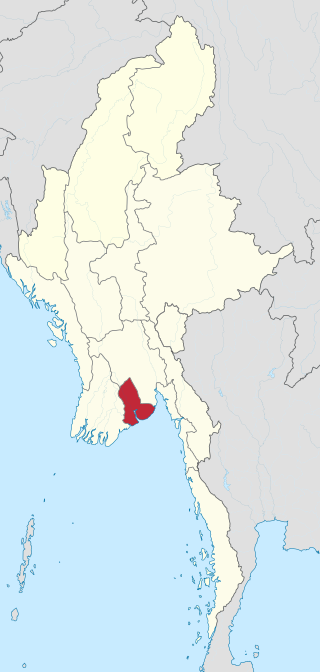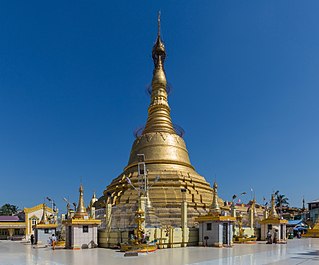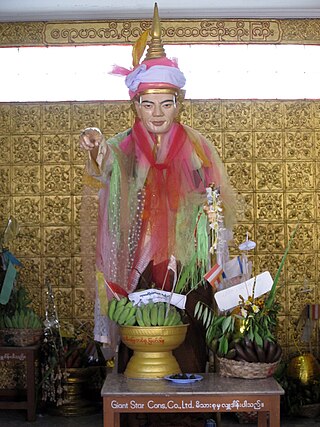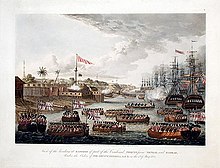
Yangon, formerly romanized as Rangoon, is the capital of the Yangon Region and the largest city of Myanmar. Yangon served as the capital of Myanmar until 2006, when the military government relocated the administrative functions to the purpose-built capital city of Naypyidaw in north central Myanmar. With over five million people, Yangon is Myanmar's most populous city and its most important commercial centre.

Mawlamyine, formerly Moulmein, is the fourth-largest city in Myanmar (Burma), 300 kilometres (190 mi) south east of Yangon and 70 kilometres (43 mi) south of Thaton, at the mouth of Thanlwin (Salween) River. Mawlamyine was an ancient city and the first capital of British Burma. The city is currently the capital and largest city of Mon State and the main trading centre and seaport in south eastern Myanmar.

Bago, formerly known as Hanthawaddy, is a city and the capital of the Bago Region in Myanmar. It is located 91 kilometres (57 mi) north-east of Yangon.

Yangon Region is an administrative region of Myanmar. Located in central Myanmar, the region is bordered by Bago Region to the north and east, the Gulf of Martaban to the south, and Ayeyarwady Region to the west. Yangon Region is dominated by its capital city of Yangon, the former national capital and the largest city in the country. Other important cities are Thanlyin and Twante. The division is the most developed region of the country and the main international gateway. The division measures 10,170 km2 (3,930 sq mi).

The Shwedagon Pagoda, officially named Shwedagon Zedi Daw, and also known as the Great Dagon Pagoda and the Golden Pagoda, is a gilded stupa located in Yangon, Myanmar.

Shin Sawbu was queen regnant of Hanthawaddy from 1454 to 1471. Queen Shin Sawbu is also known as Binnya Thau or Old Queen in Mon. Queen Shin Sawbu and Queen Jamadevi of Haripunjaya are the two most famous among the small number of queens who ruled in mainland Southeast Asia.

The Botataung Kyaik De Att Pagoda is a famous pagoda located in downtown Yangon, Myanmar, near the Yangon river. The pagoda was first built by the Mon around the same time as was Shwedagon Pagoda—according to local belief, over 2500 years ago, and was known as Kyaik-de-att in Mon language. The pagoda is hollowed within, and houses what is believed to be a sacred hair of Gautama Buddha.

The Shwemawdaw Pagoda is a Buddhist stupa located in Bago, Myanmar. At 125 m (410 ft) in overall height, the Shwemadaw is the tallest stupa in the country, and probably in Southeast Asia.

Dagon Township is located immediately north of downtown Yangon. The township comprises five wards, and shares borders with Bahan Township in the north, Ahlon Township in the west, Mingala Taungnyunt Township in the east, and Lanmadaw Township, Latha Township and Pabedan Township in the south.

Pazundaung Township is a township located in the southeastern part of Yangon, Myanmar. The township consists of ten wards, and shares borders with Botataung Township in the west and the south, Mingala Taungnyunt Township in the northwest, Thaketa Township in the north and the Pazundaung Creek in the east. Pazundaung is connected to Dawbon Township across the Maha Bandula Bridge. The township has nine primary schools, three middle schools and four high schools as well as a hospital. Pazundaung Market and Yegyaw Market are the main shopping bazaars of the area.
The Great Bell of Dhammazedi was a bronze bell, believed to be the largest bell ever cast. It was cast on 5 February 1484 by order of King Dhammazedi of Hanthawaddy Pegu, and presented to the Shwedagon Pagoda of Dagon.
Binnya U was king of Martaban–Hanthawaddy from 1348 to 1384. His reign was marked by several internal rebellions and external conflicts. He survived the initial rebellions and an invasion by Lan Na by 1353. But from 1364 onwards, his effective rule covered only the Pegu province, albeit the most strategic and powerful of the kingdom's three provinces. Constantly plagued by poor health, U increasingly relied on his sister Maha Dewi to govern. He formally handed her all his powers in 1383 while facing an open rebellion by his eldest son Binnya Nwe, who succeeded him as King Razadarit.

Bo Bo Gyi traditionally refers to the name of a guardian deity unique to each Burmese Buddhist temple or pagoda. Bo Bo Gyi is typically depicted as a nearly life-sized elderly man, dressed in a curved cap and sometimes carrying a cane, to signify old age. Offerings of scarves and paso are common by worshipers. There are many Bo Bo Gyi shrines throughout the country, and some are more widely respected than others. The Shwenyaungbin Bo Bo Gyi shrine between Yangon and Bago is often visited by new car owners hoping to have their cars blessed by the Bo Bo Gyi spirit at that site.

The Burmese–Siamese War (1759–1760) or Alaungpaya's War was the military conflict between the Konbaung dynasty of Burma (Myanmar) and the Ban Phlu Luang Dynasty of the Ayutthaya Kingdom of Siam, in which the Burmese forces under King Alaungpaya of the Konbaung dynasty invaded Siam. After about a century of relative hiatus of Burmese–Siamese conflicts, this war reignited the new round of military conflicts between Burma and Siam that would last for about a century to come.

The Maha Wizaya Pagoda is a pagoda located on Shwedagon Pagoda Road in Dagon Township, Yangon, Myanmar. The pagoda, built in 1980, is located immediately south of the Shwedagon Pagoda on Dhammarakhita Hill. The enshrined relics were contributed by the King of Nepal, while the pagoda's hti (umbrella) was consecrated by Ne Win, the country's former leader. The construction of this particular pagoda is believed by some scholars to have been a form of merit-making on the part of Ne Win.

The Singu Min Bell, also known as the Maha Gandha Bell, is a large bell located at the Shwedagon Pagoda in Yangon, Myanmar (Burma). It was donated in 1779 by King Singu, the fourth king of Konbaung Dynasty. The official Pali name of the bell is Maha Gandha, which means "Great Sound".
Maung Htaw Lay was Magistrate of Moulmein (Mawlamyine) from 1838 to 1853 during the early British colonial period of Myanmar (Burma), and governor of Dala from 1805 to 1827 during the Konbaung period. Prior to his defection to the British in 1827, he had been a Royal Burmese Army commander, and had fought in the First Anglo-Burmese War (1824–26). At Moulmein, Htaw Lay became one of the most senior indigenous officials in the colonial government. He moved to Yangon (Rangoon) in 1853 after the British annexation of Lower Burma. He successfully used his influence with the colonial government to stop the occupation forces' pillaging of Buddhist shrines around Yangon, and with the help of his son-in-law Maung Khaing, spent the rest of his life restoring the Shwedagon Pagoda.
The architecture of Myanmar, in Southeast Asia, includes architectural styles which reflect the influence of neighboring and Western nations and modernization. The country's most prominent buildings include Buddhist pagodas, stupas and temples, British colonial buildings, and modern renovations and structures. Myanmar's traditional architecture is primarily used for worship, pilgrimage, storage of Buddhist relics, political activism and tourism.

Manussiha, is a Burmese half-man half-lion mythical creature believed to be created by Buddhist missionary monks to protect a new-born royal baby from being devoured by rakshasis (ogresses) from the sea. Its statues are usually found guarding the four corners of a pagoda. It has a human head and torso and lion hindquarters. Thus, it can be called a Burmese sphinx. Notably, Manussiha is the symbol in the seal of Shwedagon Pagoda and the patch badge of Shwe Dagon Pagoda Security.

Bangkaeo Campaign or the Battle of Bangkaeo was a military conflict between Burma under the Konbaung dynasty and the Siamese Thonburi Kingdom under King Taksin in February–April 1775, in which Maha Thiha Thura, the Burmese commander, sent an expeditionary force to invade Western Siam through the Three Pagodas Pass. The Burmese stationed at Bangkaeo in modern Ratchaburi Province. King Taksin ordered the Siamese armies to completely encircle the Burmese at Bangkaeo, resulting in the starvation and defeat of the Burmese at Bangkaeo.





















